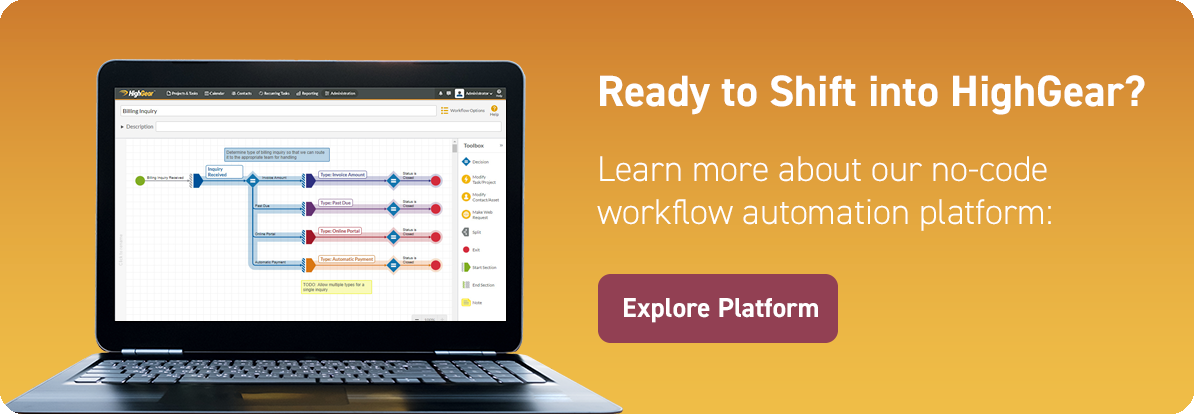
Workflow Automation enables the replacement of paper-based and manual processes using digital tools (typically workflow automation software) that integrate with existing business systems and controls.
The tactical aim is to ensure that the right workers are working on the right tasks at the right time and have everything they need to complete work tasks available to them when they need it.
Workflow automation means businesses may standardize work, ensuring preset business rules and compliance policies are met, reducing or eliminating human error and deviation, and providing visibility and accountability at every stage of the automated process.
A more succinct definition of workflow automation would be:
“Workflow Automation is defined as the design, creation, deployment and automation of business processes based upon preset rules where work tasks are automatically triggered and routed between people, technology and data.”
The Primary Benefits of Workflow Automation
Automating manual tasks, workflows, and processes can provide a business with multiple benefits; with the most significant ones being:
- Improved efficiency – automated workflows reduce manual and repetitive tasks that would otherwise waste time and resources;
- Enhanced cost-efficacy – automated workflows can help reduce costs as they speed up business processes and optimize resources;
- Increased productivity – automating workflows eliminates time-consuming and redundant tasks, ensuring employees can focus on the most significant projects, enhancing their productivity;
- Increased accuracy and reduction in deviations – workflow automation reduces the risk of errors as it eliminates unnecessary inputs and ensures data and processes are updated regularly;
- Increased visibility into work in almost real-time – workflow management software allows project managers and higher management to monitor business processes more accurately, providing them with real-time visibility into each project;
- Granular accountability down to the individual level – through workflow automation software, businesses can automatically assign tasks to individuals enhancing accountability;
- Reduction in use of assumptions/feelings and increased use of facts in decision making – workflow automation can help boost collaboration between teams and individuals, allowing everyone across company departments to share ideas and facts to make more informed decisions and work in harmony;
- The ability to impose meaningful KPIs and generate real-world data for use in process improvement – workflow automation provides businesses with more detailed insight into their processes, allowing them to set more meaningful KPIs and optimize workflows;
- Increased data security – workflow automation solutions, such as HighGear, offer business users state-of-the-art security, increasing information security across the organization.
These are not the only benefits of deploying a workflow automation platform. There are other ‘softer’ benefits, such as improved customer satisfaction (reduction in wait times, reduction in errors), improved job satisfaction (employees can demonstrate their productivity with facts), and improved vendor relations (improved communications and visibility into work outside the organization).
Why Do You Need Workflow Automation?
Many modern organizations are struggling with the digital transformation challenge. In many instances, task management tools still rely largely upon human memory, such as whiteboards, email, telephone, spreadsheets, post-it notes, etc. How to unify internal and external business communications with such tools?
A workflow automation platform allows organizations to drastically reduce reliance upon these communications and tracking tools, instead ensuring that all work task information and communications are either conducted within the platform or maintain a record of communications within the relevant work tasks.
Far less reliance is placed upon fallible human memory or task-tracking spreadsheets, which may not have been shared after being updated by a worker somewhere else in the company. Instead, the workflow platform maintains this information in a central repository which can be distributed or accessed by anyone with authority to do so (usually using Role-based Permissions).
Workflow Automation Examples
All departments within any organization can benefit from workflow automation. Some of the most significant use cases for implementing an automated workflow management system include:
- Finance – finance departments can automate tasks and processes to eliminate manual data entry, manage complex reporting, facilitate approval processes, accept payments, etc;
- Manufacturing – workflow automation reduces human error in the manufacturing while also reducing redundancies, increasing quality control, and enhancing overall collaboration between various teams resulting in faster and more reliable manufacturing processes;
- Human resources – HR departments can use workflow automation to automate such processes as employee onboarding or document flow across the company, eliminating communication gaps;
- Information security – workflow automation software uses state-of-the-art security tools to protect sensitive information across departments, as well as have notification systems in play that allow IT departments to react faster and monitor the overall company’s security ecosystem more easily.
- Sales – by integrating a customer relationship management platform (CRM) with a workflow automation solution, businesses can automate and enhance customer communication, automate form completion, and internal collaboration.
The Value of Workflow Automation
In essence, you need a workflow automation system because it delivers a far more consistently positive experience for your customers, both external and internal, when it comes to finished work product.
Work is more effectively managed r while people can do more with the resources they have. Furthermore, business process automation arms your team and department heads with the data and information needed to drive better business performance using facts, not feelings. “I feel we are busy” can be replaced with, “We increased production output by x% without an increase in headcount.”
Ultimately, you need workflow automation because it allows you to create a competitive advantage over manually-driven competitors, as you achieve the ROI of workflow automation by delivering better quality work and services at a better price point while enjoying faster and better decision-making. And that is precisely what HighGear’s workflow software can provide you with.
How HighGear Can Help Automate Workflows
Automating workflows without a workflow management software platform is nearly impossible. The problem is that many technology platforms that offer workflow and process automation are complicated to use and they often lack functionality. Many of them require advanced coding knowledge, or the platforms offer workflow automation as a secondary or tertiary capability. That is not the case with HighGear.
Our powerful all-in-one workflow automation software platform offers a no-code process management solution designed with business users in mind. With HighGear’s workflow process automation system, you will be able to design, automate, and manage custom workflows without any IT or coding skills, providing you with a fast and reliable solution for full business automation.
HighGear’s workflow automation tools and solutions include:
- A visual workflow designer for a simplified and easier-to-control business process management and automation;
- Automated notifications that allow business users to react faster, meet deadlines, and collaborate easier;
- A permission-based system that allows you to automatically set who can access specific data and projects, enhancing overall control over workflows;
- Streamlined task routing tools that automatically ensure industry compliance across departments, teams, and individual employees;
- In-depth data analytics helps access real-time data and manage documentation for faster and easier process optimization.
Learn more about our workflow automation software and schedule a consultation to see how HighGear can help you design, manage, and automate workflows. It’s time to shift your business to higher gear, and our platform is here to help you achieve that.

